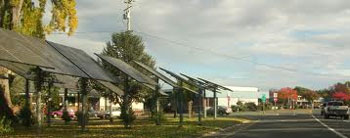Have you thought about this? To spread small solar faster, require it on all new homes and buildings.
That’s what San Francisco unanimously approved, the first large city to do so. Smaller cities in California – Lancaster and Sebastopol, have been doing it since 2013. Culver City, CA. requires solar PV on large commercial developments, and Hawaii mandates solar hot water systems on new homes.
As of January 2017, all new buildings up to 10 stories high must install solar systems, either for water heating or electricity. It builds on California’s building energy codes that require new and renovated buildings to be "solar-ready" – oriented toward the south, roofs clear and unshaded.
The "Better Roofs Ordinance" is expected to apply to 200 buildings, adding 50,000 solar panels, based on the construction pipeline in 2014, reports San Francisco Examiner.
Solar arrays in Sebastopol:

The city’s goal is to reach 100% renewable electricity by 2025, and to get there the city needs to ramp both efficiency and renewable energy. Mandating solar systems has been "demonstrated as being highly cost effective," Barry Hooper at San Francisco’s Department of Environment told the SF Examiner.
Besides solar’s importance regarding climate change, it is crucial in drought-prone places like California. Its more often appreciated for the fact that it – and wind – are the only electricity sources that require very little water.
Read our articles, California Prepares for Net-Zero Energy Residential Buildings and San Francisco Announces 0-50-100 Plan to Fight Climate Change.
